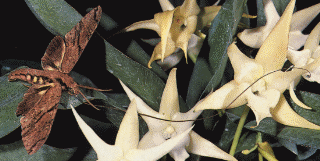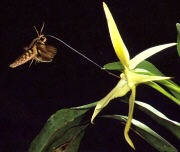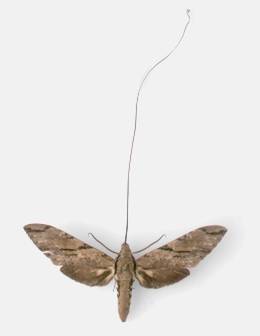Darwin’s Predicted Moth
Posted by: Loren Coleman on February 12th, 2009
Michel Raynal has written about Charles Darwin’s discovery of the following “predicted” moth.

Darwin’s hawk moth, Xanthopan morgani praedicta, and the star orchid, Angraecum sesquipedale (Photograph : Marcel Lecoufle)
On Charles Darwin’s 200th birthday, it seems only right to revisit an animal discovery of some significance tied to his observation abilities and openmindedness regarding animals.

The predicted moth
In 1862, the famous naturalist Charles Darwin published a book on the evolutionary biology of orchids, On the Various Contrivances by which British and Foreign Orchids are Fertilised by Insects. Studying the angraecoids, he remarked that they were pollinisated by specific insects. One of these orchids from Madagascar, Angraecum sesquipedale, had nectaries eleven and a half inches (28.6 cm) long, with only the lower inch and a half (3.8 cm) filled with nectar. From the structure of this orchid, Darwin “predicted” the existence of an unknown moth:
“It is, however, surprising that any insect should be able to reach the nectar: our English sphinxes have probosces as long as their bodies ; but in Madagascar there must be moths with probosces capable of extension to a length of between ten and eleven inches !” (Darwin 1862).
Darwin then made an experiment. He took a cylinder, one-tenth of an inch (2.5 mm) in diameter, and pushed it down through the cleft of the rostrellum:
“By this means alone I succeeded in each case in withdrawing the pollinia ; and it cannot, I think, be doubted that a large moth must thus act ; namely, by driving its proboscis up to the very base, through the cleft of the rostrellum, so as to reach the extremity of the nectary ; and then withdrawing its proboscis with the pollinia attached to it.”
This insect would affect of course the fertilization of the orchid, and Darwin concluded to the survival of this moth from ecological evidence:
“The pollinia would not be withdrawn until some huge moth, with a wonderfully long proboscis, tried to drain the last drop. If such great moths were to become extinct in Madagascar, assuredly the Angraecum would become extinct.”
In a letter published in the June 12, 1873, issue of Nature, W.A. Forbes asked if readers were aware of such moths in Madagascar, and he proposed an identification:
“They would probably be Sphingidae of some kind, as no other moths would combine sufficient size and length of proboscis.” (Forbes 1873).
Herman Müller, in the July 17 issue of the same year, mentioned that his brother had caught in Brazil a sphinx “the proboscis of which has a length of about 0.25 metres”, demonstrating that Darwin’s moth was not at all impossible (Müller 1873). In the second edition of his book (1877), the father of natural selection remarked:
“This belief of mine has been ridiculed by some entomologists, but we now know from Fritz Müller that there is a sphinx-moth in South Brazil which has a proboscis of nearly sufficient length, for when dried it was between ten and eleven inches long. When not protruded it is coiled up into a spiral of at least twenty windings.” (Darwin 1877).
Meanwhile, Alfred Russel Wallace, the father of biogeography, commented at greater length on this orchid, firstly in an article for the Quarterly Journal of Science (1867), then in his book Contributions to the Theory of Natural Selection (1871), and he came to the same conclusion :
“I may here mention that some of the large sphinx moths of the tropics have probosces as long as the nectary of Angraecum sesquipedale. I have carefully measured the proboscis of a specimen of Macrosilia cluentius [=Cocytius cluentius] from South America, in the collections of the British Museum, and find it to be nine inches and a quarter long ! One from tropical Africa (Macrosilia morgani) [=Xanthopan morgani] is seven inches and a half. […]. That such a moth exists in Madagascar may be safely predicted ; and naturalists who visit that island should search for it with as much confidance as astronomers searched for the planet Neptune, and I venture to predict they will be equally successful !” (Wallace 1867, 1871).
This last remark alluded to German astronomer Galle, who had searched for, and found, the planet Neptune, after French mathematician Le Verrier predicted its existence and position, from calculations on the orbite of Uranus, the then last known planet of the solar system — a well-known case in the history of sciences, often mentioned for its significance in epistemology.
And the idea of a close relation with the large sphingid of tropical Africa, Xanthopan morgani, which has a proboscis about 20 cm, was quite judicious and prophetic. This “cryptolepidoptere” was actually found and described 41 years after Darwin’s prediction: it belonged to that very species, but it was a new sub-species, which Rothschild and Jordan named Xanthopan morgani praedicta in 1903, i.e. “predicted”, which is fully justified (Rothschild and Jordan 1903). This insect has a wing span of 13 to 15 cm, of the color of a dead leaf and its proboscis is actually 25 cm (ten inches) long (figure 3).
This contribution to cryptozoology is remarkable, as it concerns the prediction, from phytobiology and ecology (i.e. from circumstancial evidence only), of an unknown moth (at the level of the subspecies), the existence and the identification of which have been experimentally confirmed a posteriori. This should be considered an important victory of a true cryptozoological mind, shared at least by two of the greatest naturalists of the nineteenth century, to wit Darwin and Wallace. Michel Raynal

About Loren Coleman
Loren Coleman is one of the world’s leading cryptozoologists, some say “the” leading living cryptozoologist. Certainly, he is acknowledged as the current living American researcher and writer who has most popularized cryptozoology in the late 20th and early 21st centuries.
Starting his fieldwork and investigations in 1960, after traveling and trekking extensively in pursuit of cryptozoological mysteries, Coleman began writing to share his experiences in 1969. An honorary member of Ivan T. Sanderson’s Society for the Investigation of the Unexplained in the 1970s, Coleman has been bestowed with similar honorary memberships of the North Idaho College Cryptozoology Club in 1983, and in subsequent years, that of the British Columbia Scientific Cryptozoology Club, CryptoSafari International, and other international organizations. He was also a Life Member and Benefactor of the International Society of Cryptozoology (now-defunct).
Loren Coleman’s daily blog, as a member of the Cryptomundo Team, served as an ongoing avenue of communication for the ever-growing body of cryptozoo news from 2005 through 2013. He returned as an infrequent contributor beginning Halloween week of 2015.
Coleman is the founder in 2003, and current director of the International Cryptozoology Museum in Portland, Maine.










So, “This contribution to cryptozoology is remarkable, as it concerns the prediction, from phytobiology and ecology (i.e. from circumstancial evidence only), of an unknown (creature) (at the level of the subspecies), the existence and the identification of which have been experimentally confirmed a posteriori.”
How does this translate to interpreting the “circumstancial evidence” of the existence of a large, bipedal, upright ape-like creature in North America’s wilderness areas?
This creature leaves evidence – footprints, stick constructions, complex “nesting” structures, prey bones, feces, track trails showing great weight, huge stride lengths and climbing abilities, stone and boulder tossings, rock clacking, wood knocking and other activities requiring an opposable thumb, voice demonstrations requiring very long vocal cords and enormous lung capacity, recorded chatter, whistles, grunts, howls and other audible “communication” sounds, plus odors and physical contacts with objects, PLUS hundreds of reports of visual sightings…
Can we then predict the existence of Sasquatch?
fuzzy:
“Can we then predict the existence of Sasquatch?”
Based on the above, and on the evidence that almost all other animal types have representatives in the tropics; the temperate zone; and one or the other or both of the polar regions, and why should apes be the exception?; AND on the evidence that described behaviors correspond quite closely with behaviors exhibited by known great apes: Yes. We certainly could.
IF science looked at the evidence objectively.
THAT is the problem.
P.S. That should be THOUSANDS of reports of visual sightings. Plus the presence, in the folklore of Native cultures spanning the continent, of an animal – described just as they do animals we know about – that corresponds quite neatly to our big buddy.
P.P.S. Let us note that folks in relevant fields laughed, at first, at the length of the Darwin moth’s tongue too. Science just hadn’t learned to think like Darwin, yet.
Let’s not forget that this moth was “predicted” because observation of this particular plant showed that the moth was actually needed for the plant to survive. The plant is here, therefore a mechanism for procreation must be here, therefore there must be an insect capable of reaching this plants pollen, therefore there must exist a moth with a 10″ proboscis. It’s really a leap to use this same arguement with our friendly neighborhood BF. (as much as I would have it otherwise:) ) Even though the evidence is there, there’s no niche that would require it’s pressence. (that we know of.)
Good post, Loren.
And good response there, DWA. You’re right about what scientists thought about the moth’s tongue.
It does not matter whether scientists laughed at him at first. He went out, did the field work, produced the evidence, and here is our moth. Scientists laughed at the idea of the Earth rotating the sun or the idea that viruses cause sickness too, but those have entered our knowledge due to work on the part of those who proposed these ideas. If the phenomena is real, and you can show that this is the case, then it will be accepted. No matter who laughed at him, here is the moth, with its long tongue, acting in precisely the capacity which Darwin predicted.
Reality is the final arbiter.
Revelation: you’re right, in that fuzzy’s question isn’t the one asked by this thread.
The question here is: hey, here’s a flower. Something’s gotta pollinate it. What does? Darwin clearly saw a reasonable answer to the question.
Fuzzy’s is: with all this evidence, shouldn’t we consider it a reasonable possibility that something natural is producing it?
Different questions.
You’re certainly right about no argument being available from vacant niches. The evidence fuzzy points to doesn’t indicate a vacant niche. But it does indicate something.
And in both cases, there is a reasonable answer. Darwin’s was right. The other one still needs work. But like the question asked by Darwin, it’s a legitimate question.
DWA- Yes, a legitimate question. Let the search continue, I say!